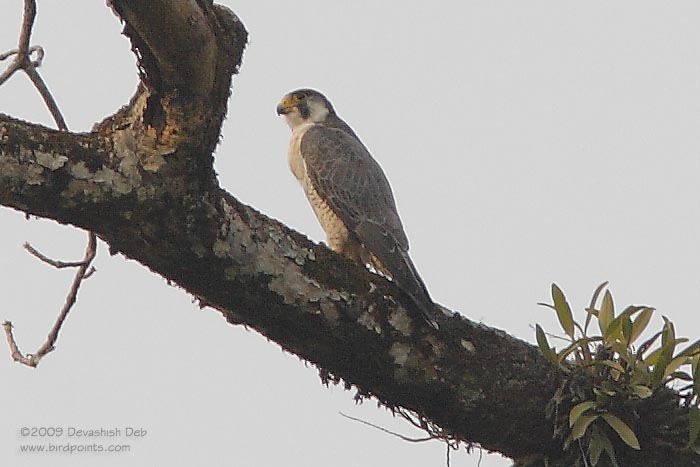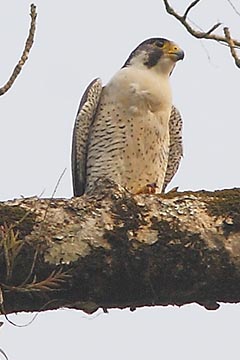|
|
| Peregrine Falcon |
Falco peregrinus |
| 21 December 2009 |
|
Possible
regional races (polytypic)
|
|
|
-F. p. babylonicus; Sclater, 1861
|
|
|
-F. p. peregrinator; Sundevall, 1837
|
|
|
-F. p. calidus; Latham, 1790
|
|
Falco peregrinus
calidus |
|
|
| Pls use the mousewheel to zoom in/out (Max 2X)
Historical  Nameri WLS & Tiger Reserve, Assam, India 11 January 2008 A solitary bird was seen 1254. Falco peregrinus. The Peregrine Falcon. Falco peregrinus, Tunstall, Ornith. Brit. p. 1 (1771); Blyth, Cat. p 13; Horsf. & M. Cat. i, p. 16; Jerdon, Madr. Jour. L. S. x, p. 79; id B. I. i, p. 21; Blyth, Ibis, 1866, p. 234; Hume, Rough Notes, p. 49; Jerdon, Ibis, 1871, p. 237; Delme Radcliffe, ibid, p. 363; A. Anderson, P. Z. S. 1871, p. 677; 1875, p. 18; Hume, SF i, p. 151; ii, p. 140; iii, pp. 19, 442; iv, pp 279, 460; xi, p. 2; id. Cat. no. 8; Hume & Dav. S. F. vi, p. 1; Scully, S.F. viii. p. 221; Vidal, S. F. ix, p. 29; Butler, ibid. p. 370; Legge Birds Ceyl. p. 101; Biddulph, Ibis, 1881, p. 39; Scully, ibid. p. 416; Gurney, Ibis, 1882, p. 293; Hume & Dav. S. F. x, p. 333; Oates, B. B. ii, p. 214; Barnes, Birds Bom. p. 9. Falco communis, Gm. Syst. Nat. p. 270 (1788); Sharpe, Cat. B. M. i, p. 376; Ball, S. F. vii, p. 196. Falco calidus, Lath. Ind. Orn. i, p. 41 (1790); Blyth, Ibis, 1863, p. 7. Bhyri F, Bhyri bacha M, H.; Bhyri dega, Tel.; Dega, Yerkli: Falcon F, Tiercel M, of British Falconers.  Coloration.
Adult. Above bluish grey, darker on the head and nape, pale on the
rump and upper tail-coverts; feathers of the head and nape, the scapulars,
and sometimes other parts of the upper plumage dark-shafted, and all
feathers except those of the head and hind-neck with dark cross-bands;
forehead whitish; a broad cheek-stripe from beneath the eye black;
primaries blackish, the inner webs, except near the end, closely barred
with white; secondaries ashy grey with darker cross-bands; tail dark
grey or blackish, with numerous ashy-grey cross-bars, closer together
and paler towards the base, extreme tip and borders near tip whitish;
lower parts white with a rufous tinge, a few brown or black spots
on the lower breast and middle of the abdomen, and narrow dark bars
on the flanks, lower wing-coverts, thigh-coverts, and under tail-coverts. Coloration.
Adult. Above bluish grey, darker on the head and nape, pale on the
rump and upper tail-coverts; feathers of the head and nape, the scapulars,
and sometimes other parts of the upper plumage dark-shafted, and all
feathers except those of the head and hind-neck with dark cross-bands;
forehead whitish; a broad cheek-stripe from beneath the eye black;
primaries blackish, the inner webs, except near the end, closely barred
with white; secondaries ashy grey with darker cross-bands; tail dark
grey or blackish, with numerous ashy-grey cross-bars, closer together
and paler towards the base, extreme tip and borders near tip whitish;
lower parts white with a rufous tinge, a few brown or black spots
on the lower breast and middle of the abdomen, and narrow dark bars
on the flanks, lower wing-coverts, thigh-coverts, and under tail-coverts.Young birds are very dark brown above, the feathers edged with rufous, the buff bases of the feathers showing about the nape; the tail-feathers with about 6 transversely oval rufous spots on each web, forming imperfect cross-bars; primaries as in adults; cheekstripe narrower; lower parts white, buff, or rufescent, spotted, except on the throat, with broad brown elongate median stripes, becoming broad spots on the flanks. After the first moult Peregrines are brownish grey above and gradually acquire a pure slaty-grey back. The spots and bars on the lower parts are much broader at first and grow smaller and narrower with age, the drops on the breast become narrow lines and ultimately disappear altogether, the bands fade off the under tail-coverts, and in very old birds only small scattered specks remain on the abdomen and triangular markings on the thighcoverts. The general tint of the lower surface varies from almost white to light rufous. Bill bluish, black at tip; cere yellow; irides brown; legs and feet yellow. Length of a female about 19; tail 7.5; wing 14.5; tarsus 2.1; mid-toe without claw 2.25; bill from gape 1.3. Males are considerably smaller: length about 16; wing 12.5. Distribution. Almost worldwide. The Peregrine is a winter visitor to Southern Asia, and is found in suitable places during the winter throughout India, Ceylon, and Burma, and even in the Laccadive and Andaman Islands. Habits, &c. The Peregrine is seldom found far from water, and is most common on the sea-coast or near rivers and large swamps, doubtless from the abundance of its prey, which consists largely of ducks and waders; pigeons, partridges, &c., are also captured by the Peregrine. It is the largest and most powerful of Indian Falcons. With one exception, observed by Layard near Jaffna in Ceylon, the Peregrine has not been recorded as breeding in India, accounts of its nesting in or near the Himalayas being doubtful. It generally lays 3 or 4 reddish eggs, speckled or blotched, in a stick nest on a cliff or sometimes on a tree. |
About/Terms
of use etc. in the home page
Copyright ©
2006-2009 birdpoints. All rights reserved.